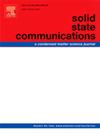Structure and magnetoelectric properties of flexible PDMS/ GaFeO3 composites
IF 2.1
4区 物理与天体物理
Q3 PHYSICS, CONDENSED MATTER
引用次数: 0
Abstract
The structure and magnetoelectric properties of flexible PDMS/GFO composites with different GFO weight percentages was studied. The XRD pattern of composites shows the presence of both GFO and PDMS phases. Raman and IR studies confirmed the presence of functional group absorption bands corresponding to PDMS and GFO in the composite system. GFO nanoparticle incorporation is confirmed from fractured micrographs of SEM images. The enhanced thermal stability of the composite material is confirmed through Thermogravimetric Analysis (TGA) and Differential Scanning Calorimetry (DSC) techniques. The field-dependant magnetization data shows a clear hysteresis loop at room temperature, indicating weak ferrimagnetic properties. A significant change in the demagnetization process occurred with the alteration in the filler composition. The frequency-dependent dielectric constant increases with an increase in filler content. Ferroelectric data confirms the room temperature ferroelectricity in the composite samples and polarization increases with filler loading. Room temperature magnetoelectric coupling is confirmed in the samples.
柔性PDMS/ GaFeO3复合材料的结构与磁电性能
研究了不同GFO含量的柔性PDMS/GFO复合材料的结构和磁电性能。复合材料的XRD谱图表明GFO相和PDMS相均存在。Raman和IR研究证实了复合体系中存在与PDMS和GFO相对应的官能团吸收带。GFO纳米颗粒的掺入从断裂的电镜图像中得到证实。通过热重分析(TGA)和差示扫描量热法(DSC)技术证实了复合材料的热稳定性增强。磁场相关磁化数据在室温下显示出明显的磁滞回线,表明弱铁磁特性。随着填料组成的改变,消磁过程发生了显著变化。频率相关介电常数随填料含量的增加而增加。铁电性数据证实了复合材料样品的室温铁电性,并且极化随填料的加入而增加。在室温下,样品的磁电耦合得到了证实。
本文章由计算机程序翻译,如有差异,请以英文原文为准。
求助全文
约1分钟内获得全文
求助全文
来源期刊

Solid State Communications
物理-物理:凝聚态物理
CiteScore
3.40
自引率
4.80%
发文量
287
审稿时长
51 days
期刊介绍:
Solid State Communications is an international medium for the publication of short communications and original research articles on significant developments in condensed matter science, giving scientists immediate access to important, recently completed work. The journal publishes original experimental and theoretical research on the physical and chemical properties of solids and other condensed systems and also on their preparation. The submission of manuscripts reporting research on the basic physics of materials science and devices, as well as of state-of-the-art microstructures and nanostructures, is encouraged.
A coherent quantitative treatment emphasizing new physics is expected rather than a simple accumulation of experimental data. Consistent with these aims, the short communications should be kept concise and short, usually not longer than six printed pages. The number of figures and tables should also be kept to a minimum. Solid State Communications now also welcomes original research articles without length restrictions.
The Fast-Track section of Solid State Communications is the venue for very rapid publication of short communications on significant developments in condensed matter science. The goal is to offer the broad condensed matter community quick and immediate access to publish recently completed papers in research areas that are rapidly evolving and in which there are developments with great potential impact.
 求助内容:
求助内容: 应助结果提醒方式:
应助结果提醒方式:


